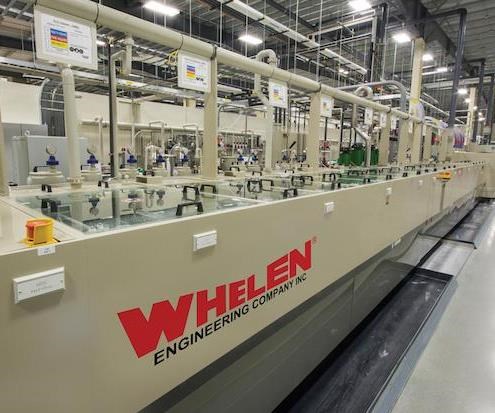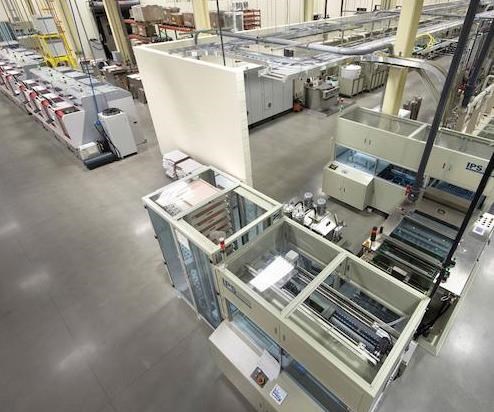New PCB Plating Process Is Reshoring Success for Whelen Engineering
Whelen Engineering was among the thousands of OEMs that sourced its printed circuit boards from Asia until increasing costs led the company to build—greenfield and in-house—America’s first new rigid PCB shop in 15 years.
Whelen is a leading manufacturer of safety lighting and sirens for automotive, aviation and emergency warning applications based in Chester, Connecticut, and Charlestown, New Hampshire. Its about-face in how it sources the brains for every product it sells tells an important story about the power of innovation, the merits of questioning common wisdom, and how both of these can generate a “proof of concept” with implications far beyond one manufacturing operation.
Whelen was founded in 1952 on the pillars of advanced production equipment, a motivated workforce, and a commitment to vertical manufacturing initiatives. In 2012, the company’s visionary CEO, John Olson, launched a new project that would take that vertical integration to an entirely new level.
At the time, Whelen was spending millions of dollars each year on PCBs from China, and prices and lead times were both on an upward trajectory. Injection molding and other critical operations had already been brought in-house, with results exceeding forecasts. A strategic decision was made to explore whether board making could be next.
In 2013, Whelen management recruited Alex Stepinski, whose experience included senior engineering and management roles at large North American PCB fabrication companies to develop a plan. He was, in his words, “all about nonconventional approaches.”
“The idea was to build a fully automated operation based on our core principles that would produce a higher quality PWB, at a lower price, with shorter lead times than offshore,” Stepinski says.

Whelen is a leading manufacturer of safety lighting and sirens for automotive, aviation and emergency warning applications.
100 Percent Reshoring
The tact requirement to achieve 100 percent reshoring was PC board output of 50 panels per hour; translating to 2,500 per week of 18- by 24-inch and 21- by 24-inch rigid and rigid-flex panels; with capacity to expand up to 10,000 panels per week over the next decade.
“We also wanted an ROI of no more than five years, and although the industry minimum average headcount for a facility of this scale is 100 workers, we wanted to achieve everything with a workforce of no more than 17 total employees,” he says.
Stepinski completed his initial design/business plan in six weeks: a unique U-shaped configuration 550 feet long, with a 4.5-hour cycle time on a 50,000-square-foot overall footprint.
A two-level command center is elevated 12 feet above the line. The first level is a chemical lab, where one technician does wet process and cross-sectional analysis testing for the entire facility, in six hours per day. Both levels also house banks of monitors that track the temperature, concentration and level of every chemical, and the progress of each order. The line uses 39 pieces of automation linking 24 value-added process steps.
“We are really focused on lean concepts of waste reduction,” Stepinski says. “Chemistry is stored in vented day tanks, with sensors monitoring levels and checking for leaks. Live inventory data is continuously available.”

ENIG Chemistry
Whelen uses Uyemura ENIG chemistry, a popular industry standard for producing uniform mid-phos EN deposits with a thin topcoat of immersion gold, over copper, and the Uyemura InternationalStarline Dash Controller, an advanced control technology for EN plating.
Dash 4-NP samples the EN plating solution, analyzes nickel and pH values, and replenishes automatically. Baths are maintained at 2 to 4 percent of optimum, and nickel is controlled within ±0.05 g/L.
Whelen selected Uyemura originally because it offered a process that did not require dummy plating of nickel, and that produced exceptionally uniform thickness deposits of gold, thus facilitating substantial overall reductions in gold usage.
Tanks are sized for three-times supply chain average lead time. The day tank system also reduces the number of manual chemical transactions by 99 percent versus a conventional facility by eliminating the hazardous, labor-intensive manual adds from the partially used drums. All adds are made via an HMI interface controlling metering pumps with safety interlocks. Laminate, masks and other solid materials are also stored in highly visible locations, with no central inventory.
At the start of production, drilled panels are placed in a tray that is barcoded; the tray then pings the database, pulling information relevant for that job, and processes it from deburr through final finish in 4.5 hours and reports. Location/status is reported in real time via hundreds of in-line sensors.
“There is a 3 percent max coefficient of variation in plated surface copper thickness; the etch system has a maximum 1.5 percent variation in etch rate,” Stepinski says. “This consistency allows us to run just one plating recipe, and one etching recipe, throughout the factory.”
The only stage where recipes change is in the imaging equipment, which is an all-digital inkjet technology, a first in the world.

Whelen built the U.S.’s first new rigid PCB shop in 15 years.
Eliminating Costs
“We do digital inkjet printing for print and etch of the inner layers and metal core products, as well as for plate and etch of the outer layers,” he says. “For plate and etch, we panel plate all outer layers and sub-composites with horizontal copper plating; however, we then tin plate the final etch resist so we have a ‘plate and etch’ process with an inkjet resist.”
Soldermask and legend processes are also inkjet, which eliminates costly steps in photolithography. They don’t have a laminator or developer for primary imaging, nor a cleaner, micro-etch or pre-dip for etch resist electroplating.
“Additionally, our tin plater is so robust, we can afford to plate only 2.2 to 2.9 microns of tin on the surface,” he says.
Due to this low thickness, two spray bars at 1.5 meters per minute are all that is needed to strip the tin after etching. Whelen only uses a drum of standard tin strip chemistry every 16,000 panels, and a drum of tin brightener every 42,000 panels. A drum of resist stripper lasts for 14,000 panels with its wax-based inkjet ink. The most difficult process to integrate in the line was the imaging technology, which is markedly different from what’s been done previously.
“We had to work with our suppliers and take it from an idea to a production process in a very short time,” he says.
The imaging integration has, however, produced the most profound benefit in terms of labor savings. In addition, one worker manages the copper plate, metallization, tin plater, etch, resist and tin stripping operations. The solder mask inkjet-based process is the only one in the world which also plugs the boards simultaneously with coating.
A thorough analysis of current product designs and roadmap tolerance requirements was used to establish process spec targets.
“Extensive experimentation with large quantities of test panels was also required to adjust the plating thickness vari-ation to the required level across our entire product mix,” Stepinski says. “But by designing it all up-front, and systematically qualifying it, we now have a robust, predictable, low-maintenance process for many years to come.”
Qualified Process Controls
Process controls were qualified to the point that no test panels are needed to interrupt production to qualify different product recipes, nor are any dummy panels required to compensate for current density edge effects. Whelen’s metallization process is green and conductive-polymer based.
The production ramp is underway and expected to be completed shortly, whereupon Whelen will have 100 percent of its PCB production back in the U.S.—and bragging rights about achieving substantial cost savings over PCBs from China.
“That includes both direct and indirect costs, as well as massive savings in cycle time,” Stepinski says. “We expect to be the first shop in the west to out-compete the Asia-Pacific region on direct PCB price per square inch.”
It is also the first totally green PCB shop.
“There is no need for wastewater permits, or air permits; liquid is 100 percent recycled, and we designed-out all of the air toxics,” says Stepinski, who added that a non-regulated resist stripper was developed as well.
“We use just 500 gallons of fresh water a day to compensate for humidity loss from our air scrubber, which runs on recycled DI water to maximize absorption efficiency,” he says. “We have the first in the world, closed loop recycling system for ammonia etchant.”
It covers every waste aspect of the system.
“We plate the copper out of the etchant, and rather than ammonium chloride for etching, we use a cocktail of ammonium sulfate and other low cost generic compounds, which we developed in partnership with a supplier to plate out the copper,” he says.
“We sell the 99.9 percent pure copper to a local recycler, and do not add any fresh chemicals to the etcher. Our plating chemistry supplier has even approved the copper quality from the etcher for reuse in the plater, which will allow us to take copper that is removed at etch to be redissolved in the plater.”
Stepinski says this reduces the company’s overall raw copper purchases by 95 percent, and enables it to metallize the circuit pattern using waste copper from the laminate.
Design-Out Pollution
The system was designed so there’s no need to vent ammonia etch; by performing the oxidation reaction offline in a separate sealed reactor, they have created a totally closed system. Rinses are regenerated with a proprietary process as well. Virtually no hazardous waste is generated; overall hazardous waste volume as a stand-alone PCB shop meets the conditions of a small quantity generator. The company is regulated at a higher level.
Whelen was able to “design-out” pollution concerns because the factory and waste treatment were a single, integrated design.
“Our operating costs for waste treatment are far below conventional systems, and even our capital investment in waste treatment was below average for a shop our size,” Stepinski says.
“There are practically no treatment chemicals used, except for minute amounts of acid and caustic. The high level of recycling that we do actually offsets most of the operating costs of our environmental systems. On a per-panel basis, conventional factories spend more money on fresh water than we spend on all of our combined regulatory operations.”
The manufacturing model developed for PCBs by Whelen is a proof of concept that’s applicable, in the company’s view, for many products.
“The key is not just automation of a single piece of equipment, in operations like drilling, plating, imaging,” Stepinski says. “But the combining of new technologies, such as inkjet and others, and the use of new, more efficient, more integrated process equipment.”
The Whelen model is a new solution that addresses this competitive advantage by engineering the integration of different processes to a new level of efficiency, according to Stepinski.
“The majority of the cost of quality in manufacturing boards is non-valued waste stemming from a lack of inter-process integration,” he says. “This can be up to 80 to 90 percent of a typical shop’s labor costs, and essentially all of the regulatory costs.”
For information on Whelen Engineering, visit whelen.com. For information on Uyemura, visit uyemura.com.
Related Content
Finisher’s ‘Top Shop’ Status Attracts Business
This competitive California finisher made it a goal to become a PF Top Shop. After earning the recognition, the company experienced an immediate increase in business and a challenge to obtain certifications.
Read MoreNADCAP Shop Digitizes to Eliminate Paper Trail
Customizable ERP software has transformed a 27-year-old manual metal finishing job shop into a state-of-the-art paperless company with full digital traceability in about 10 months.
Read MoreTop Shop Aces Outstanding Customer Service
More than a finishing shop, this anodizing, powder coating and vacuum resin impregnating business goes above and beyond for its customers by being a resource for whatever their finishing needs might demand.
Read MoreTrivalent Chrome Overview
As the finishing industry begins to move away from the use of hexavalent chromium to trivalent chromium, what factors should finishers consider as they make new investments? Mark Schario, chief technology officer for Columbia Chemical offers a helpful overview of this complicated topic.
Read MoreRead Next
Episode 45: An Interview with Chandler Mancuso, MacDermid Envio Solutions
Chandler Mancuso, technical director with MacDermid Envio discusses updating your wastewater treatment system and implementing materials recycling solutions to increase efficiencies, control costs and reduce environmental impact.
Read MoreA ‘Clean’ Agenda Offers Unique Presentations in Chicago
The 2024 Parts Cleaning Conference, co-located with the International Manufacturing Technology Show, includes presentations by several speakers who are new to the conference and topics that have not been covered in past editions of this event.
Read MoreDelivering Increased Benefits to Greenhouse Films
Baystar's Borstar technology is helping customers deliver better, more reliable production methods to greenhouse agriculture.
Read More













.jpg;maxWidth=300;quality=90)







